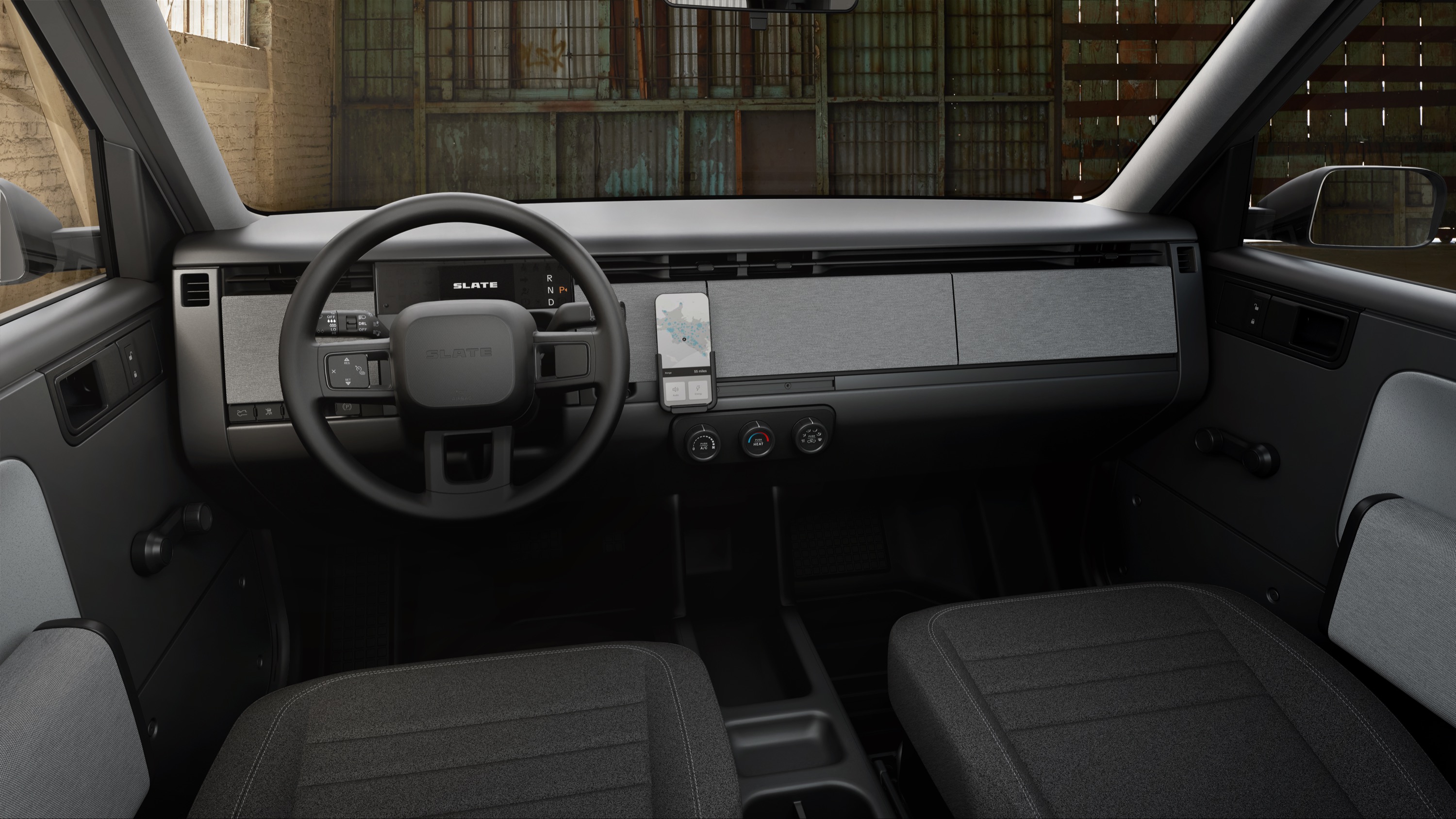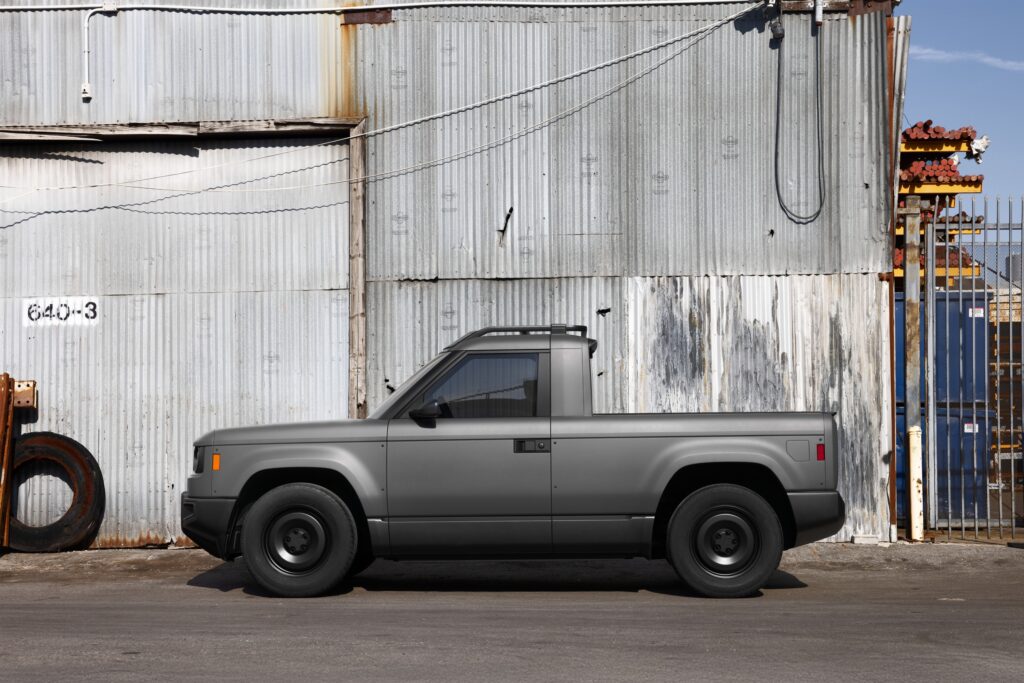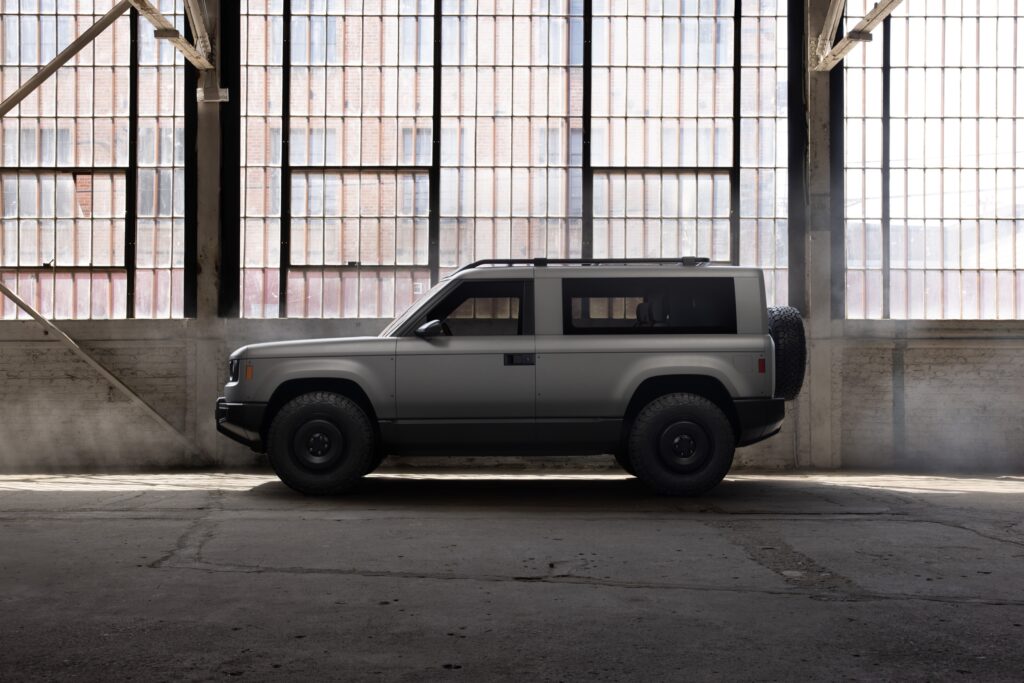Bezos-backed startup wants to sell a bare-bones EV truck for $20,000
April 24, 2025
In one of the strangest launches we’ve seen in a while, Slate Auto, the reportedly Jeff Bezos-backed electric vehicle startup, unveiled its first EV, the Slate Truck. Notably, the vehicle is capable of a claimed 150 miles (241 km) of range at a starting price of less than $20,000, assuming federal clean vehicle tax credits continue to exist.
Slate caused a lot of social media froth when it parked a pair of styling concepts (not functional vehicles) in Venice, California, advertising bizarre fake businesses. Today, the company unveiled the vehicle to the press at an event near the Long Beach Airport.
You wanted a bare-bones EV? Here it is.
The Blank Slate, as the company calls it, is “all about accessible personalization” and includes a “flat-pack accessory SUV Kit” that turns the truck from a pickup into a five-seat SUV and another that turns it into an “open air” truck. The aim, according to a spokesperson for Slate Auto, is to make the new vehicle repairable and customizable while adhering to safety and crash standards.

If you’ve ever said you’d buy a bare-bones truck with no infotainment and manual windows if only they’d build one, it’s time to get out your wallet.
Credit:
Slate Auto
The truck will come with a choice of two battery packs: a 57.2 kWh battery pack with rear-wheel drive and a target range of 150 miles and an 84.3 kWh battery pack with a target of 240 miles (386 km). The truck has a NACS charging port and will charge to 80 percent in under 30 minutes, peaking at 120 kW, we’re told. The wheels are modest 17-inch steelies, and the truck is no speed demon—zero to 60 mph (0–97 km/h) will take 8 seconds thanks to the 201 hp (150 kW), 195 lb-ft (264 Nm) motor, and it tops out at 90 mph (145 km/h).
Because the truck will be built in just a single configuration from the factory, Slate Auto will offer body wraps instead of different paint colors. Rather than relying on a built-in infotainment system, you’ll use your phone plugged into a USB outlet or a dedicated tablet inside the cabin for your entertainment and navigation needs. The Slate Truck will also aim for a 5-star crash rating, according to a company spokesperson, and will feature active emergency braking, forward collision warning, and as many as eight airbags.
It sounds good on paper (and it looks good in person), but the spec sheet is littered with things that give us pause from a production and safety standpoint. They present hurdles the startup will have to surmount before these trucks start landing in people’s driveways.

Legally, there has to be some way to show a backup camera feed in here, but you could do that in the rearview mirror.
Credit:
Slate Auto
For example, the truck has manual crank windows, steel wheels, HVAC knobs, and an optional do-it-yourself “flat-pack accessory SUV kit.” All of these low-tech features are quite cool, and they’re available on other vehicles like the Bronco and the Jeep, but there are a number of supplier, tariff, and safety hurdles they present for an upstart company. There is plenty of Kool-Aid for the automotive press to get drunk on—and if this truck becomes a real thing, we’ll be fully on board—but we have a lot of questions.
Can Slate really build an EV that cheap?
First, there’s the price. The myth of the sub-$25,000 electric vehicle has been around for more than 10 years now, thanks to Tesla CEO Elon Musk’s perpetual promise of an affordable EV.
That vehicle may never exist due to the cost of the current battery and manufacturing technology that we use to make modern EVs. While much of that cost is tied up in the battery, prices have improved as components have come down in price. That combination has led companies like Rivian and Scout to promise SUVs that could start at around $40,000, which is much more attainable for the average buyer. But $40,000 is still wide of that $25,000 marker.
Slate Auto
Slate Auto
There’s also the issue of federal incentives. Without the full clean vehicle tax credit, the new Slate Truck will actually cost at least $27,500 before tax, title, and so on. Bezos’ team seems to be betting that Trump won’t get rid of the incentives, despite abundant signals that he intends to do just that. “Whether or not the incentive goes away, our truck will be a high-value, desirable vehicle,” a spokesperson for Slate Auto told Ars.
Then there are the retro and basic components Slate Auto says it will use for the truck, many of which are made in China and are thus subject to the Trump tariffs. Even though the company says it will manufacture the vehicles in the US, that doesn’t mean that the components (battery, motors, steel wheels, window cranks, and HVAC knobs) will be made stateside. If the tariffs stick, that sub $30,000 vehicle will become measurably more expensive.
For example, the last automaker to use manual crank windows was Jeep in the JL Wrangler, and as of 2025, the company no longer offers them as an option. Ford also recently phased out hand-wound windows from its Super Duty trucks. That’s because electric switches are cheaper and readily available from suppliers—who are mostly located in China—and because automakers that offer manual and powered windows had to have two different door assembly lines to accommodate the different tech. That made building both options more expensive. Power windows are also somewhat safer for families with younger children in the backseat, as parents can lock the roll-down feature.

It’s an ambitious idea, and we hope it works.
Credit:
Slate Auto
Slate Auto’s spokesperson declined to talk about partners or suppliers but did say the company will manufacture its new truck in a “reindustrialized” factory in the Midwest. A quick look at the plethora of job listings at SlateAuto on LinkedIn shows that that factory will be in Troy, Michigan, where there are around 40 jobs listed, including body closure engineers (for the flat-pack kit), prototype engineers, seating buyers/engineers, controls and automation engineers, a head of powertrain and propulsion, wheels and suspension engineers, plant managers, and more. Those are all very pivotal, high-level positions that Slate will need to fill immediately to bring this vehicle to market on the timeline it has set.
Slate Auto also hasn’t said how it will ensure that these DIY vehicle add-ons will be certified to be safe on the road without the company taking on the liability. It will likely work the way Jeep and Bronco handle their accessories, but both Stellantis and Ford have robust service networks they can count on, with dealerships around the country able to help owners who get into a pickle trying to install accessories. Slate doesn’t have that, at least at the moment. Slate’s SUV kit, for example, will include a roll cage, rear seat, and airbags. It will be interesting to see how the company ensures the airbags are installed safely—if it allows DIY-ers to do it.
Will young people actually want it?
Finally, there’s the biggest question: Will younger generations actually plunk down $20,000 or more to own a Slate vehicle that won’t go into production until the fourth quarter of 2026—more than a year and a half out—especially in the face of the economic upheaval and global uncertainty that has taken hold under the second Trump administration?

Tesla, Rivian, and Lucid have all been at the mercy of their suppliers, sinking deadlines and making prices rise. How will Slate Auto avoid that trap?
Credit:
Slate Auto
Data shows that while some young people have started to opt for devices like dumbphones and may prefer the novelty of no tech, they may also prefer to rent a car or rideshare instead of owning a vehicle. Given Slate Auto’s Bezos backing, I’d imagine that the company would be willing to, say, rent out a Slate Truck for a weekend and charge you a subscription fee for its use. It’s also conceivable that these could become fleet vehicles for Amazon and other companies.
Slate Auto says it will sell directly to consumers (which will anger dealers) and offer a nationwide service network. A spokesperson at Slate Auto declined to give more details about how that might all work but said the company will have more to announce about partners who will enable service and installation in the future.
Even with all the unanswered questions, it’s good to see a company making a real effort to build a truly affordable electric vehicle with funky retro styling. There are a number of things Slate Auto will have to address moving forward, but if the company can deliver a consumer vehicle under that magic $25,000 marker, we’ll be roundly impressed.
Search
RECENT PRESS RELEASES
Related Post







